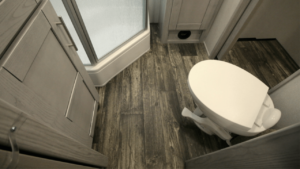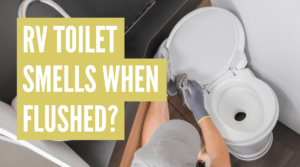Camper FAQs is reader-supported. Buying through links on our site may earn us an affiliate commission. As an Amazon Associate I earn from qualifying purchases.
The fact there are so many sizes of campers, from Class-A motorhomes down to pop-up campers, and styles of camping, from boondocking to staying at luxurious RV parks, has led to the development of many different types of toilets.
The 7 main types of RV toilets include:
- Gravity Flush Toilet
- Cassette Toilet
- Dry Flush Toilet
- Macerating Toilet
- Vacuum Flush Toilet
- Incinerator Toilet
- Composting Toilet
Let’s explore the different types of toilets for RVs, how they work, and their pros and cons.
1. Gravity Flush Toilet

A gravity flush toilet is the most common type of RV toilet found in recreational vehicles. It uses the force of gravity to move the waste from the toilet bowl into the blackwater tank below.
It’s a popular choice for RVs because of its simplicity, reliability, and ease of maintenance.
Here’s how a gravity flush toilet works:
- When you use the toilet, waste falls into the toilet bowl, which contains a small amount of water.
- When you push the lever or step on the pedal to flush the toilet, the valve opens, and the force of gravity pulls the waste and water from the bowl down into the black water-holding tank located beneath the toilet.
- Once the valve closes, a small amount of water from the RV’s freshwater supply refills the bowl.
Gravity flush toilets in RVs don’t require electricity or complicated mechanisms to work.
However, they depend on a properly maintained holding tank system for storing and eventually disposing of the waste. To keep the system functioning well and to avoid unpleasant odors, it’s important to regularly clean the toilet (See How to Clean an RV Toilet for a step-by-step cleaning guide) and empty and clean the black tank.
2. Cassette Toilet
A cassette toilet is a type of compact toilet system often found in smaller RVs, camper vans, and even boats. They are popular for many reasons, but mainly because they don’t require a black tank or connection to a sewer system.
Here’s how a cassette toilet works:
- When you use a cassette toilet, the waste goes into the bowl like any other toilet.
- Unlike a traditional RV toilet, which flushes waste into a large, fixed black water holding tank, a cassette toilet stores the waste in a removable container called a “cassette.” that sits directly under the toilet bowl.
- To flush the toilet, you typically use a hand lever, foot pedal, or button, depending on the specific model. This opens a valve at the bottom of the bowl, allowing the waste to drop into the cassette. The toilet typically uses a small amount of water from the freshwater supply to rinse the bowl and help wash the waste into the cassette.
- When it’s time to empty the cassette, you can typically access it from outside the RV and remove it. The cassette has a built-in spout and a vent button, which makes emptying it into a regular toilet or designated waste disposal site. After emptying, you simply rinse the cassette, add toilet chemicals if needed, and reattach it for future use.
Cassette toilets are popular in smaller RVs because they save space and make waste disposal more manageable. However, due to the small cassette size, they require more frequent emptying than traditional gravity flush toilets.
3. Dry Flush Toilet
A dry flush toilet is a type of waterless toilet system that, as the name suggests, doesn’t use water for flushing. This makes it suitable for RVs, campers, boats, and even off-grid homes.
These increasingly popular toilets are designed to be environmentally friendly, save water, and minimize odors.
Here’s how a dry flush toilet works:
- When you use the toilet, the waste goes into the “bowl,” which is basically a durable, biodegradable liner.
- To flush the toilet, you simply press a button. Instead of using water, however, the dry flush toilet uses a motor that twists and seals the plastic bag containing the waste and prevents odors from escaping. At the same time, the rotating action positions a fresh bag in the bowl, ready for the next use.
- When the cartridge is full (usually after 15-20 uses), remove it from the toilet and dispose of the waste-filled bags in the trash, as you would with a bag of dog waste or baby diaper. Then, replace the used cartridge with a new one.
Dry flush toilets are popular in situations where water conservation is important or traditional plumbing is unavailable. Plus, they do not leave any bad odor!
However, they do require a power source (usually batteries) to operate the motor, and the cartridges need to be replaced regularly, which can be frustrating and is an ongoing expense.
4. Macerating Toilet
A macerating toilet uses a built-in electric motor to liquefy the waste before pumping it into the holding tank. Compared to gravity flush toilets, the advantage of this is that the toilet does not need to be near the blacktank.
Here’s how a macerating toilet works:
- After the waste goes into the bowl, you press a button or step on a pedal to flush the toilet. This activates the macerator, a powerful electric motor with sharp blades that grind the waste into a slurry (a thin, soupy mixture).
- Once the waste is macerated, it’s pumped out of the toilet through a pipe. Because the waste has been liquified, it can travel through narrow pipes without clogging them.
- The macerated waste is then pumped into a holding tank, where it’s held until it’s time to empty it at a designated dump station.
Macerating toilets are popular in situations where traditional gravity-based plumbing is not feasible or in some RVs with multiple toilets.
However, they require electricity to operate, and the macerating mechanism needs regular maintenance to ensure it continues working properly.
5. Vacuum Flush Toilet
A vacuum flush toilet uses a vacuum pump to create suction that quickly and efficiently moves waste from the toilet bowl into a holding tank. Vacuum flush toilets are popular for their water-saving capabilities and powerful flushing action.
Here’s how a vacuum flush toilet works:
- Turn on the vacuum pump system.
- After waste is deposited in the bowl, you press a button or step on a pedal to flush the toilet. This action opens a valve at the bottom of the bowl, and the vacuum created by the pump quickly pulls the waste and a small amount of water from the bowl.
- The waste is then pumped into a black water holding tank, where it is stored until it’s time to empty it at a dump station.
Vacuum flush toilets are popular in situations where water conservation is essential or if the toilet and blacktank are positioned far apart.
However, they require electricity to operate the vacuum pump, and the system needs regular maintenance to ensure it continues working properly.
6. Incinerator Toilet
An incinerating toilet is a type of toilet that uses high temperatures to convert human waste into ash. Instead of using water for flushing, the waste is burned, eliminating the need for a traditional holding tank. Incinerating toilets can be electric or gas-powered.
Here’s a general overview of how an incinerating toilet works:
- The user deposits waste in the toilet bowl, typically lined with a special disposable liner.
- Once finished, the waste is moved into the incineration chamber.
- The incineration process is initiated, which uses high temperatures to burn the waste, reducing it to about a teaspoon of sterile ash.
- After the incineration process is complete and the unit has cooled down, the ash can be safely removed and discarded.
Incinerating toilets are useful when boondocking where traditional waste disposal systems may not be available or feasible. They also reduce water usage, can be disposed of easily, and are odor-free.
However, incinerating toilets can be more expensive to purchase and operate than other types of toilets. Plus, you’ll need a supply of liners on hand at all times to use the toilet.
7. Composting Toilet
A composting toilet is an eco-friendly toilet system often found in off-grid homes, RVs, boats, and even tiny houses. It doesn’t use water for flushing and instead turns human waste into a nutrient-rich compost that can be used to fertilize plants.
Here’s how a composting toilet works:
- When you use the toilet, the waste goes into a special container. Many composting toilets separate solid waste from liquid waste because they decompose differently.
- In the solid waste container, the composting process begins. You’ll typically add a bulking agent, like sawdust, shredded paper, peat moss, or other carbon-based material, to the container, helping the waste to break down properly.
- After a few weeks or months, depending on the toilet model and usage, the solid waste will have turned into compost. You then remove the compost from the toilet and use it as fertilizer or dispose of it in a designated area in accordance with local regulations.
Composting toilets are a great option for eco-conscious RVers or where traditional plumbing isn’t available. However, they require regular maintenance, like adding bulking agents, emptying the containers, and cleaning to ensure they continue working properly and remain odor-free.
What is the Best Type of RV Toilet?
The best type of RV toilet will fit your camping style, the size of your RV, and your budget. In most situations, a regular gravity-fed toilet is likely the best option (and what most RVs come standard with). But if you enjoy boondocking (camping without hookups), have a smaller RV or campervan, or simply don’t like the idea of maintaining a black tank, you might want to look into a cassette or incinerator toilet.
For those wanting the most eco-friendly toilet, composting and incinerator toilets are great options.
I know choosing the right toilet can be a bit confusing, so check out our guide to the best RV toilets to learn more about the top models.







Write a comment